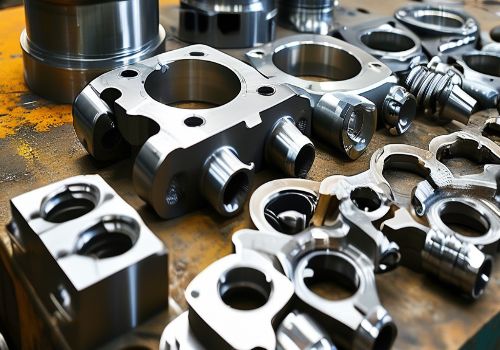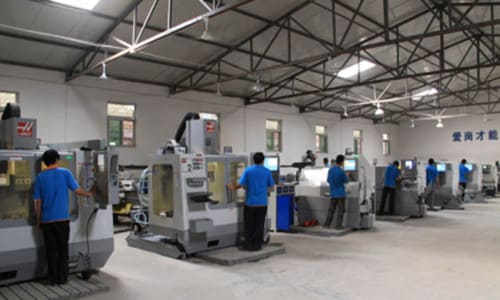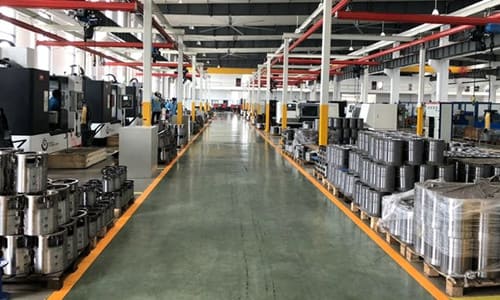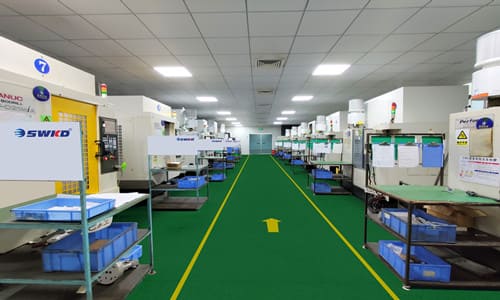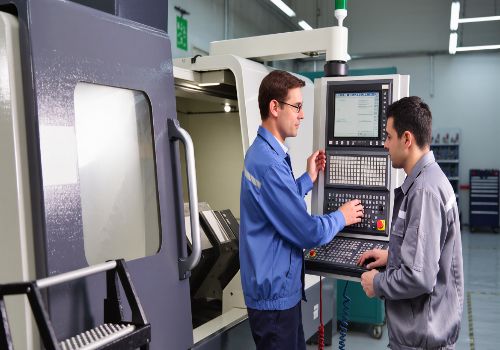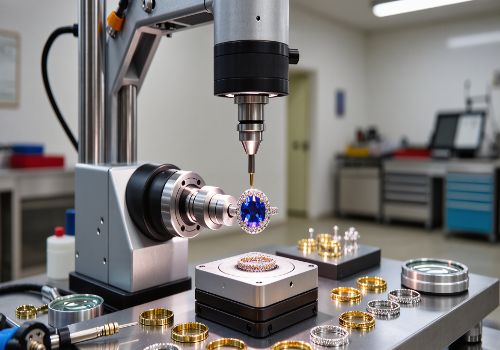The future of AI in CNC machining is transforming traditional computer-controlled machines into intelligent, self-optimizing systems that can perceive, learn, and make autonomous decisions, dramatically improving precision, efficiency, and reliability in manufacturing processes.
Introduction: The Dawn of Intelligent Manufacturing
For decades, Computer Numerical Control (CNC) machining has represented the pinnacle of manufacturing precision, enabling the creation of complex components with remarkable accuracy. Yet despite these advancements, traditional CNC systems have remained largely dependent on human programming, monitoring, and intervention. This landscape is undergoing a radical transformation as Artificial Intelligence (AI) technologies converge with advanced manufacturing, creating machines that don’t just execute commands but actually think, adapt, and optimize in real-time.
The global manufacturing sector is witnessing what industry experts describe as a transition “from digital revolution to intelligent awakening” in CNC technology . This shift is powered by AI systems that can analyze vast amounts of data, recognize patterns, and make decisions that traditionally required human expertise. The implications are profound: reduced operational costs, unprecedented quality control, and manufacturing capabilities that were once the domain of science fiction are becoming reality on factory floors worldwide.
In this comprehensive exploration, we’ll examine how AI technologies are being integrated into CNC machining, the tangible benefits they’re delivering today, and what the future holds for this powerful synergy between artificial intelligence and advanced manufacturing.
How AI is Revolutionizing CNC Machining: Core Technologies
Intelligent Process Optimization
At the heart of AI’s transformation of CNC machining is its ability to optimize complex manufacturing processes autonomously. Modern AI-powered CNC systems utilize instruction domain big data analytics to compare virtual simulation data with actual measured results in real-time, creating what’s known as a “dual-code linkage control” system . This enables continuous process refinement that can boost machining efficiency by up to 20% while simultaneously improving accuracy .
These systems work by collecting and analyzing data from multiple sources during the machining process, including:
-
Cutting forces and vibration patterns
-
Thermal variations and their effects
-
Tool wear characteristics
-
Material behavior under different conditions
Through machine learning algorithms, the system identifies optimal machining parameters and can automatically adjust feeds, speeds, and paths to maintain ideal conditions throughout the manufacturing process.
Predictive Maintenance and Tool Monitoring
Unexpected equipment failure and tool wear represent significant costs in traditional CNC operations. AI is revolutionizing this aspect through sophisticated predictive maintenance capabilities . By continuously monitoring equipment conditions through integrated sensors, AI systems can detect subtle changes in vibration patterns, temperature fluctuations, and power consumption that indicate potential problems long before they cause downtime .
The financial implications are substantial. Unplanned manufacturing downtime can cost thousands of dollars per hour in lost productivity. AI-driven predictive maintenance helps transition manufacturers from reactive to proactive maintenance schedules, significantly reducing both unexpected breakdowns and overall maintenance costs .
For cutting tools specifically, AI-powered monitoring systems can now detect tool wear and predict potential failure with remarkable accuracy. Research teams like those at Shandong University have developed advanced monitoring methods that address “the challenge of low monitoring accuracy in small-batch processing caused by the randomness of tool wear” . These systems can automatically adjust machining parameters or signal for tool replacement before quality is compromised.
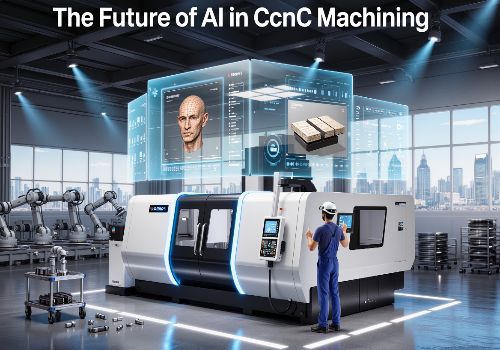
Autonomous Quality Control and Precision Enhancement
AI systems are bringing unprecedented levels of precision to CNC machining through real-time quality control and adaptive correction. The integration of AI with advanced sensor technologies enables continuous monitoring of critical quality metrics during the machining process itself, allowing for immediate adjustments rather than post-process discovery of defects .
The precision improvements are particularly notable in complex machining operations. For example, when manufacturing precision components like scroll plates, AI-enhanced systems have demonstrated the ability to improve contour accuracy by up to 75% compared to conventional CNC approaches . This level of precision enhancement is achieved through continuous micro-adjustments that compensate for tool deflection, thermal expansion, and other variables that traditionally challenge machining accuracy.
Smart Programming and Human-Machine Interaction
One of the most dramatic shifts brought by AI in CNC machining is the transformation of programming interfaces. Next-generation CNC systems now feature AI assistants capable of natural language interaction . Operators can use voice commands to generate complex machining programs, significantly lowering the barrier to creating optimized tool paths .
The implications for workforce development and operational efficiency are substantial. These AI assistants can reportedly perform at a level comparable to engineers with several years of experience, and in some cases, “automatic repair capabilities surpass those of engineers with three years of experience” . This doesn’t replace human operators but rather augments their capabilities, allowing skilled machinists to focus on higher-value tasks while the AI handles routine programming and troubleshooting.
Table: AI Applications in Modern CNC Machining
| AI Capability | Traditional Approach | AI-Enhanced Approach | Impact |
|---|---|---|---|
| Process Optimization | Manual parameter setting based on experience | Real-time adaptive control based on sensor data | Up to 20% efficiency improvement |
| Quality Control | Post-process inspection | In-process monitoring with immediate correction | Up to 75% precision improvement |
| Tool Management | Scheduled changes regardless of actual wear | Predictive monitoring of actual tool condition | Reduced tool costs & downtime |
| Programming | Manual G-code programming | Voice-controlled natural language interface | Faster setup & skill gap bridging |
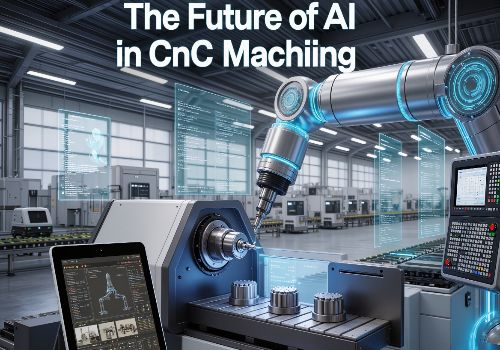
Real-World Implementations: AI in Action
Huazhong 10-Type Intelligent CNC System
A prime example of AI’s transformative potential in CNC machining is Huazhong 10-type intelligent CNC system developed by Wuhan Huazhong Numerical Control Co. This system represents a groundbreaking advancement as “the world’s first CNC system integrating AI chips and large AI models” .
The system employs an innovative “1+2+3” architecture:
-
1 Intelligent Base: Hardware integration of AI chips and intelligent sensor modules that form the system’s “neural network” and “super brain”
-
2 Digital Threads: Complete data tracking throughout the equipment lifecycle and machining process
-
3 Functional Subsystems: Covering process optimization, precision improvement, and health assurance
In practical applications, this AI-powered system has demonstrated remarkable results. When deployed for machining smartphone casings and automotive motor components, it achieved approximately 10% improvements in rough machining efficiency . Similarly, when manufacturing scroll plates for energy applications, the system boosted contour accuracy by 75% compared to conventional approaches.
AI-Enhanced CAD/CAM Systems
The AI revolution extends beyond the machine tools themselves to encompass the entire manufacturing workflow. Companies like Cimatron are pioneering AI integration into CAD/CAM software, introducing capabilities such as automatic feature detection and component classification .
Their AI systems can automatically recognize geometric elements like grooves, slots, fillets, and various hole types (through-holes, blind holes, etc.) . This capability significantly reduces programming time and helps optimize tool paths automatically based on the detected features. As these systems evolve, they’re increasingly able to provide manufacturing recommendations based on recognized features, customer requirements, productivity needs, and available machinery.
Specialized AI for High-Performance Manufacturing
Academic and research institutions are pushing the boundaries of AI in specialized machining applications. The Advanced Processing and Intelligent Equipment research team at Shandong University has made significant progress in AI-enabled high-performance manufacturing, particularly in challenging areas like tool condition monitoring in complex processing scenarios .
Their work addresses a critical manufacturing challenge: the accurate monitoring of tool conditions during small-batch processing where the random nature of tool wear has traditionally made reliable monitoring difficult . By developing integrated knowledge and data-driven physical information neural networks, they’ve broken through the deployment bottlenecks of high-precision tool condition monitoring models in complex machining environments.
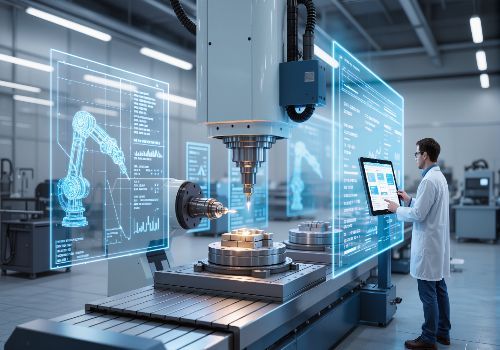
The Tangible Benefits: Why Manufacturers Are Adopting AI
Dramatic Efficiency Gains
The implementation of AI in CNC machining translates to substantial bottom-line benefits through multiple efficiency channels:
-
Reduced Programming Time: AI-assisted programming can slash the time required to create and optimize machining programs
-
Faster Machining Cycles: Adaptive control systems optimize machining parameters in real-time, reducing cycle times
-
Minimized Downtime: Predictive maintenance and early fault detection prevent unexpected production interruptions
-
Reduced Setup Time: Automated feature recognition and tool path optimization accelerate job changeovers
Collectively, these efficiencies enable manufacturers to increase throughput without additional capital investment in machinery, significantly improving return on existing assets.
Unprecedented Quality and Consistency
AI systems bring a level of consistency to manufacturing quality that is difficult to achieve through human supervision alone. By continuously monitoring and adjusting machining parameters, AI-enabled CNC systems can:
-
Maintain tight tolerances throughout extended production runs
-
Compensate for tool wear automatically during machining operations
-
Adapt to material variations that might otherwise affect quality
-
Reduce scrap rates through early detection of potential defects
This consistent quality is particularly valuable in industries with stringent certification requirements, such as aerospace, medical devices, and automotive manufacturing.
Bridging the Skills Gap
The manufacturing sector faces an increasingly severe shortage of experienced machinists and programmers. AI technologies are helping to bridge this gap by:
-
Allowing less experienced operators to program complex parts through natural language interfaces
-
Capturing and codifying the knowledge of experienced machinists in AI systems
-
Providing intelligent guidance for troubleshooting and optimization
-
Reducing dependency on scarce highly-skilled operators
This democratization of expertise enables manufacturers to maintain and even increase capability levels despite workforce challenges.
Challenges and Implementation Considerations
Data Infrastructure Requirements
Implementing AI in CNC machining requires robust data infrastructure, including:
-
Sensor Networks: Comprehensive monitoring of machining processes
-
Data Processing Capabilities: Handling the substantial data volumes generated
-
Connectivity: Reliable links between machines, systems, and analytics platforms
-
Storage Solutions: Secure, scalable storage for historical data analysis
Manufacturers must assess and potentially upgrade their digital infrastructure to fully leverage AI capabilities.
Integration with Existing Systems
Most manufacturers operate mixed fleets of equipment from various generations and vendors. Successfully implementing AI often requires:
-
Interface adapters for older equipment
-
Data standardization across different control systems
-
Phased implementation strategies
-
Custom integration solutions for unique environments
Security and Data Governance
As CNC systems become more connected and data-driven, they also become potential targets for cyber threats. Robust security protocols must address:
-
Protection of proprietary manufacturing data
-
Security of operational technology networks
-
Access control for AI systems
-
Data integrity verification
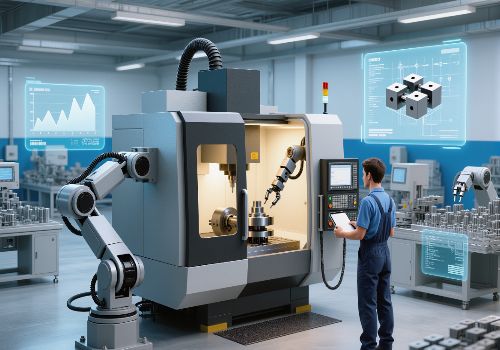
The Future Outlook: Where AI in CNC Machining is Headed
Increasing Vertical Integration
The future will see deeper integration of AI across the entire manufacturing workflow, from design through production to quality verification. We can expect:
-
Generative Design Integration: AI systems that not only manufacture but also contribute to optimal component design
-
Supply Chain Connectivity: AI systems that adjust production based on material availability and demand signals
-
Automated Quality Documentation: Systems that automatically generate compliance documentation based on process data
Edge AI and Distributed Intelligence
As AI capabilities grow more sophisticated, we’ll see a shift toward distributed intelligence architectures:
-
On-Device Processing: More AI processing at the machine level for faster response times
-
Federated Learning: Systems that improve across multiple installations while maintaining data privacy
-
Specialized AI Chips: Hardware specifically designed for manufacturing AI applications
Human-AI Collaboration
The future of CNC machining isn’t about replacing people with machines, but rather creating powerful collaborations between human expertise and artificial intelligence. We’re moving toward:
-
Intuitive Interfaces: More natural interaction between operators and complex systems
-
Augmented Reality Integration: Visual overlays that provide real-time insights during setup and operation
-
Adaptive Training Systems: AI that learns individual operator preferences and working styles
Conclusion: Embracing the AI Transformation in CNC Machining
The integration of Artificial Intelligence into CNC machining represents one of the most significant advancements in manufacturing technology since the introduction of computer numerical control itself. We’re transitioning from an era of automated machines to intelligent manufacturing ecosystems that can perceive, reason, and optimize continuously.
The evidence is clear: AI technologies are delivering substantial improvements in efficiency, precision, and reliability right now. Systems like Huazhong 10-Type are demonstrating that AI can boost productivity by 10-20% while simultaneously improving quality . As these technologies mature and become more accessible, they offer manufacturers powerful tools to compete in an increasingly challenging global landscape.
For manufacturing businesses, the question is no longer whether to adopt AI technologies, but how quickly they can begin their implementation journey. The competitive advantages are simply too significant to ignore. By starting with specific pain points—whether in tool management, quality control, or programming efficiency—manufacturers can begin building their AI capabilities progressively, delivering quick wins while building toward a comprehensively intelligent manufacturing environment.
The future of CNC machining is intelligent, adaptive, and increasingly autonomous. Manufacturers who embrace this AI-driven transformation will position themselves at the forefront of their industries, ready to capitalize on the opportunities of tomorrow’s manufacturing landscape.



